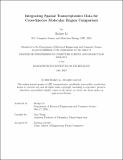Integrating Spatial Transcriptomics Data for Cross-Species Molecular Region Comparison
Author(s)
Li, Bridget
DownloadThesis PDF (17.53Mb)
Advisor
Wang, Xiao
Terms of use
Metadata
Show full item recordAbstract
Comparative analysis of brain patterns across species can advance understanding of different biological processes and functions. Spatially resolved transcriptomics (SRT) technologies present the ability to measure gene expression of single cells within tissues, enabling the detection of unique spatial molecular patterns in the brain. Several computational methods that rely on cellular neighborhood information have been developed for characterizing molecular tissue regions in SRT data. Here, we show that spatial integration (SPIN) improves the performance of existing methods and enables the clustering of molecular tissue regions. Then, we test SPIN and signal-processing approaches on SRT data from mouse and macaque brains. We integrate the brain atlases of these two species to identify shared and distinct spatial molecular patterns. This work offers new insights into spatial molecular features between mouse and macaque brains and proposes a framework for integrating SRT datasets on a large scale.
Date issued
2024-05Department
Massachusetts Institute of Technology. Department of Electrical Engineering and Computer SciencePublisher
Massachusetts Institute of Technology